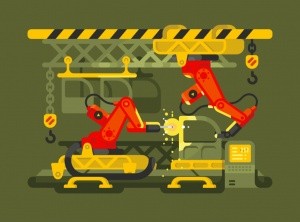
Manufacturing Templates Start the discussion!

Manufacturing is the process of turning raw materials into sellable finished goods.
Where are the inputs of the manufacturing process recorded?
The ‘Inventory’ is the term used to encapsulate the idea of a single document for all of the goods that are to be factored into the manufacturing process. Inventory Management is thus a crucial aspect for a manufacturing firm. It involves monitoring the non-capitalized assets and stock items. Their job is to ensure the flow of goods from the manufacturer to warehouses and from warehouses to the point of sale.
What does the manufacturing process start with?
Raw materials (also known as ‘feedstock’) are unprocessed materials that are used to produce finished goods and sellable items. These are also included in the inventory and must be acknowledged as ‘Land’ in the fundamental factors of production; the others being labour, enterprise and capital.
Logistics is the term used to label the process of implementing and organizing a multi-stage and complex operation. Working in logistics entails keeping track of the flow of goods from the point of origin – where the goods are still raw materials, to the point of consumption – which follows the point of sale in some cases where delivery is required.
What is included in a manufacturing template?
An Output Chart can be used to illustrate the production results of the manufacturing. It is a useful tool for depicting the goods produced in a more digestible form. This allows the corporation to calculate trends that are taking place.
KPI Dashboards are incredibly useful tools during the manufacturing process. They allow the company to decide which Key Performance Indicators metrics are going to be analysed, and then to apply them in a functional and efficient way. Dashboards make the access to data, and the representation of it, easier.
What follows the manufacturing process?
Manufacturing Excel Templates also often include Sales Management. This encapsulates the practical application of the techniques that surround and follow the manufacturing process. This is seen by many corporations as one of the most fundamental processes in a business. The sale of goods and the resulting profit are what underpin most commercial entities.
How are employees kept track of and registered during the manufacturing process?
A Scheduling System is also often included. This is mostly used to register the hours worked by the employees. The rotas which identify when and where a person will be working at a specific time are incorporated as well. Logistics and the supply chain are not just about tracking the movement of goods along the route to becoming merchandise. Those in management positions in these areas are also responsible for the organisation of the people employed to operate the procedures. These employees come under the heading of ‘labour’ in the fundamental factors of production.
Advantages of having a well-drilled manufacturing process:
=> deadlines are established and more likely to be met
=> the inventory is kept up to date and costs are accounted for
=> instructions can be given more efficiently
=> the aims and outputs are clearer and thus more achievable
Types of Manufacturing Processes
There are various processes used within the manufacturing industry to determine how a company will produce its products.
1. Process manufacturing: follows recipes or formulas and creates products which cannot be broken down at the end of the production cycle.
2. Discrete manufacturing: uses a bill of materials (BOM) and follows instructions to create finished, assembled goods. At the end of the process, it is possible to break down the product into its distinct parts. Examples of discretely manufactured products include automobiles, computers and some toys.
3. Repetitive manufacturing (REM): used for repeated production that is committed to a specific production rate. It is comprised of dedicated production lines that repeatedly make the same products.
4. Job manufacturing: uses production areas instead of assembly or production lines and focuses on producing smaller amounts of custom products, including made-to-order (MTO) and made-to-stock (MTS) goods.
5. 3D or additive printing: produces goods from numerous composites and materials, building layers to create a three-dimensional solid object from a digital model. This is the newest manufacturing process.
To find out more about the Manufacturing Process, follow these links
Most popular Templates
 User-friendly 3 statement 5 year rolling financial projection Excel model for existing/startup manufacturing business1,8984add_shopping_cart$59.00
User-friendly 3 statement 5 year rolling financial projection Excel model for existing/startup manufacturing business1,8984add_shopping_cart$59.00 by Projectify
by Projectify

Manufacturing Company Budget Template
Take control of your business' financials with this Manufacturing Company Budget Template.4,588Discussadd_shopping_cart
Manufacturing Company Financial Model - Dynamic 10 Year Forecast
Financial Model providing a dynamic up to 10-year financial forecast for a startup Manufacturing Company.6484add_shopping_cart$149.00 by Profit Vision
by Profit Vision

Food Manufacturing Budget Excel Template
Food Manufacturing Company Budget Template - take control of your business' financials.2,9951add_shopping_cart
Startup: Physical Product, Financial Model, Fund Raise, and Valuation
Comprehensive Financial Model with easy inputs. P&L, Balance Sheet, Cash Flow, Valuation, ROI, and Breakeven2,2262add_shopping_cart$79.00 by Conrad W Beckman
by Conrad W Beckman

Track Your Employees Production Worksheet
Use this tool to track your employees' daily production.1,802Discussadd_shopping_cart$12.00 by Bruce Kaufmann
by Bruce Kaufmann








